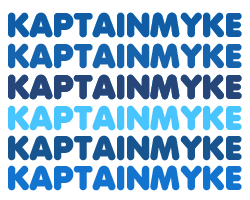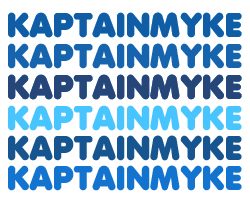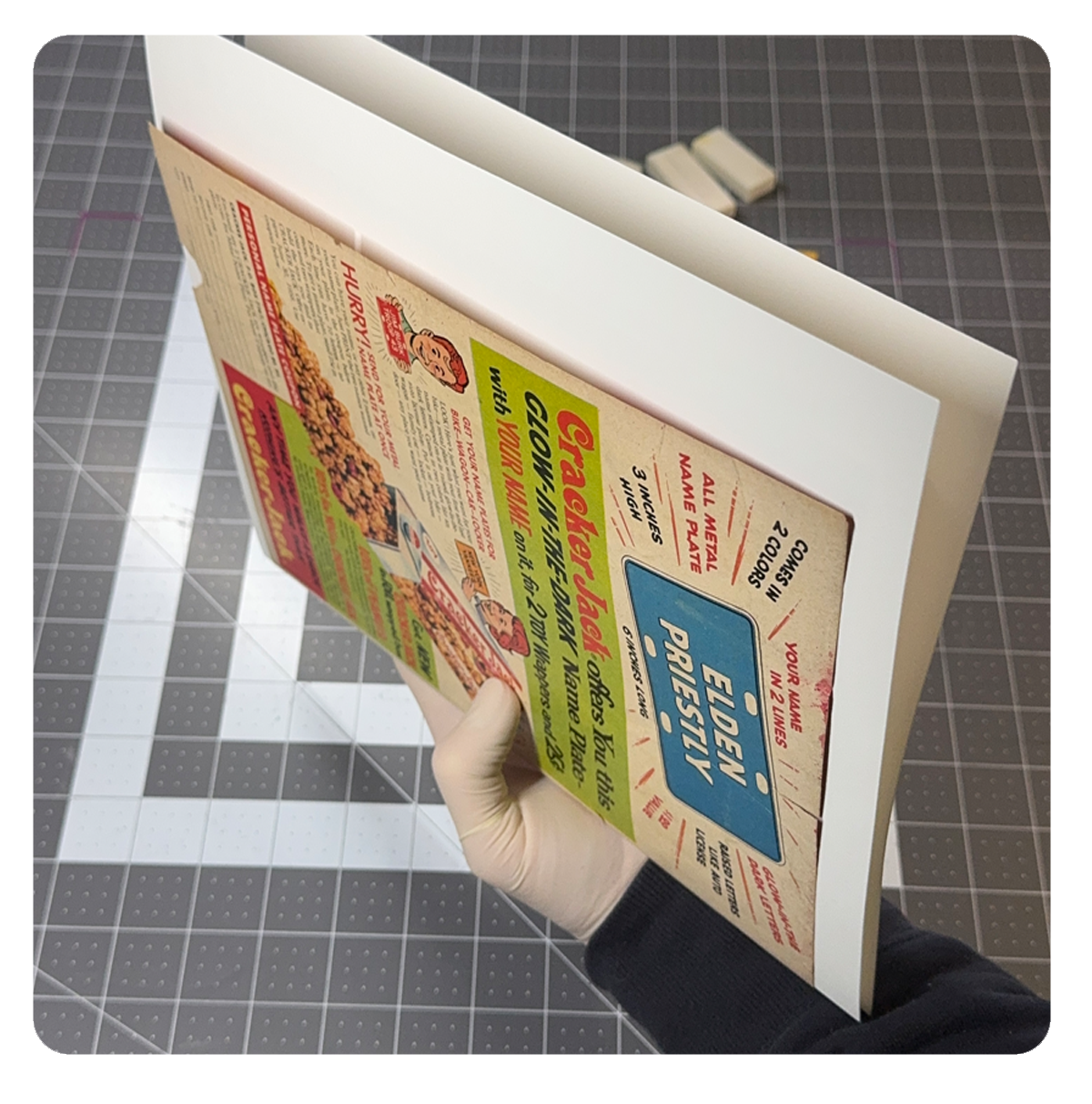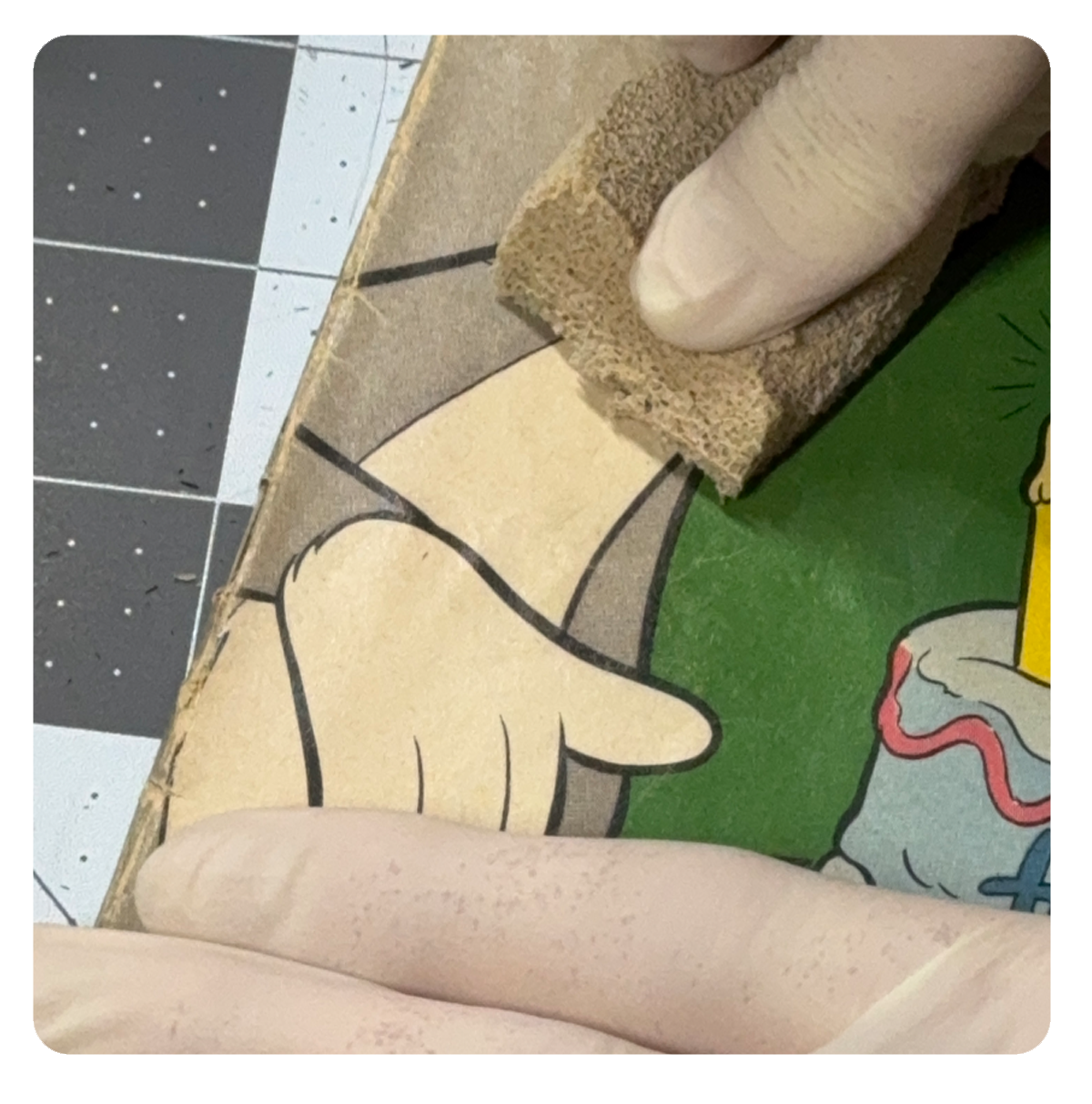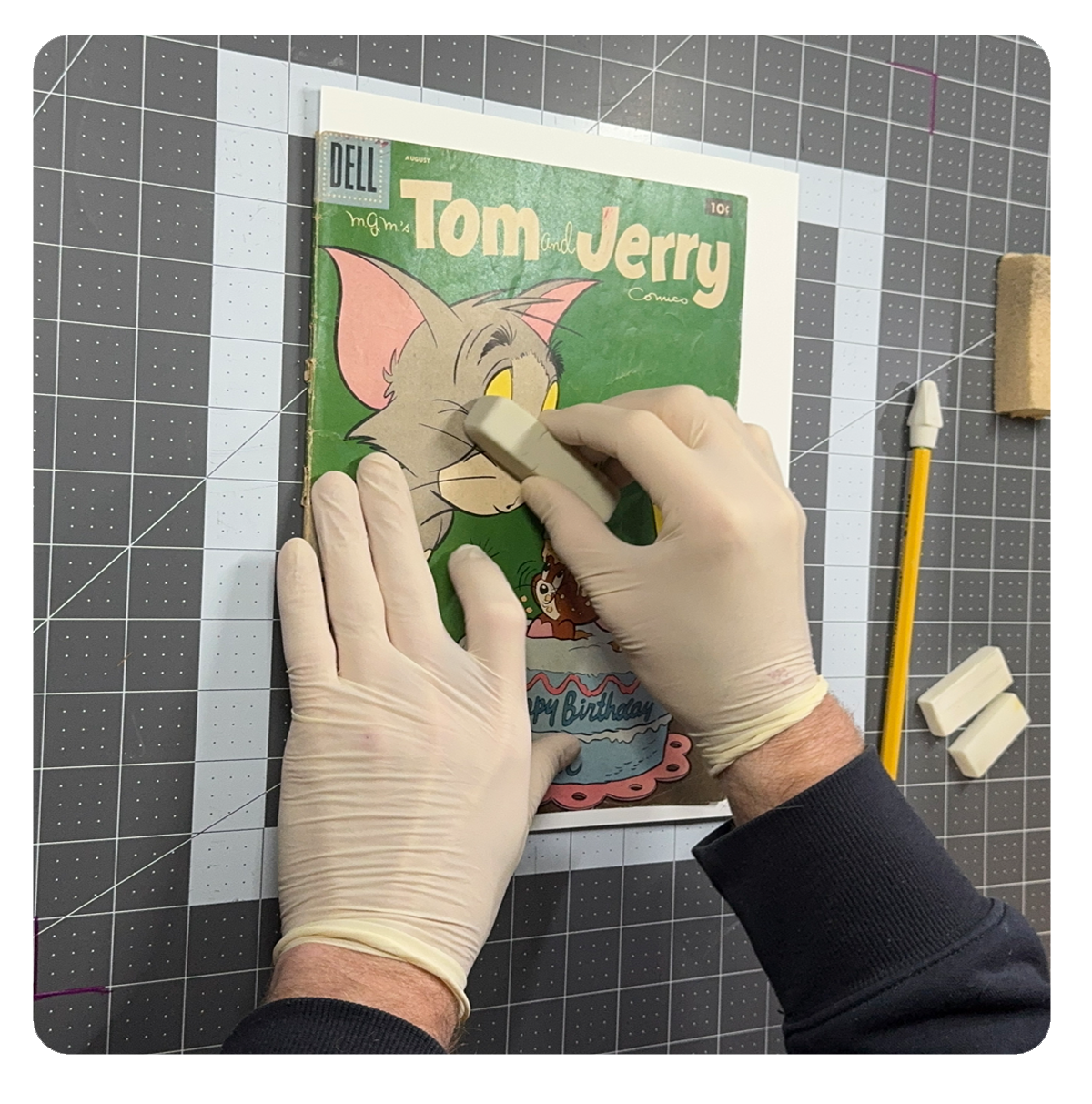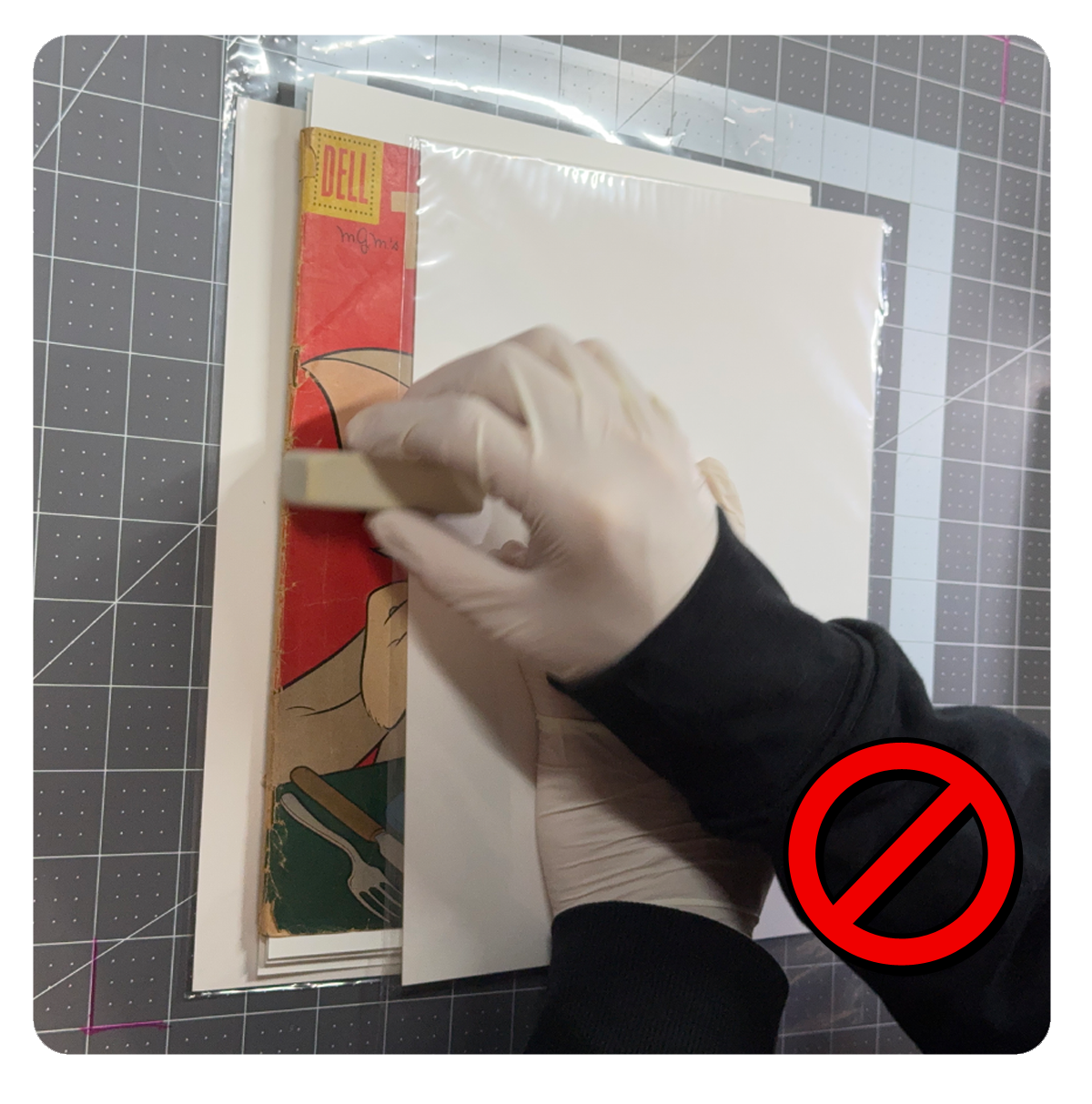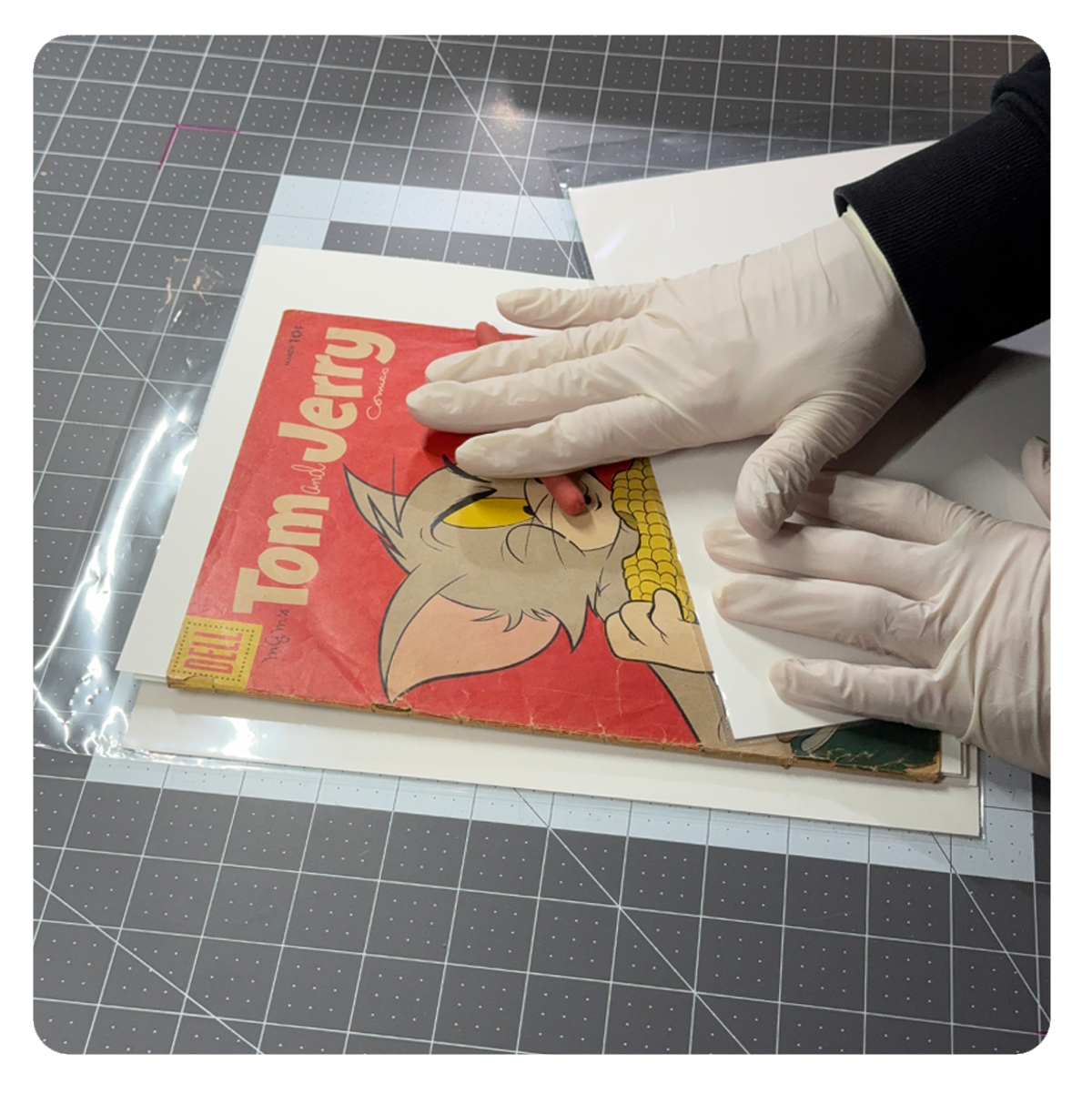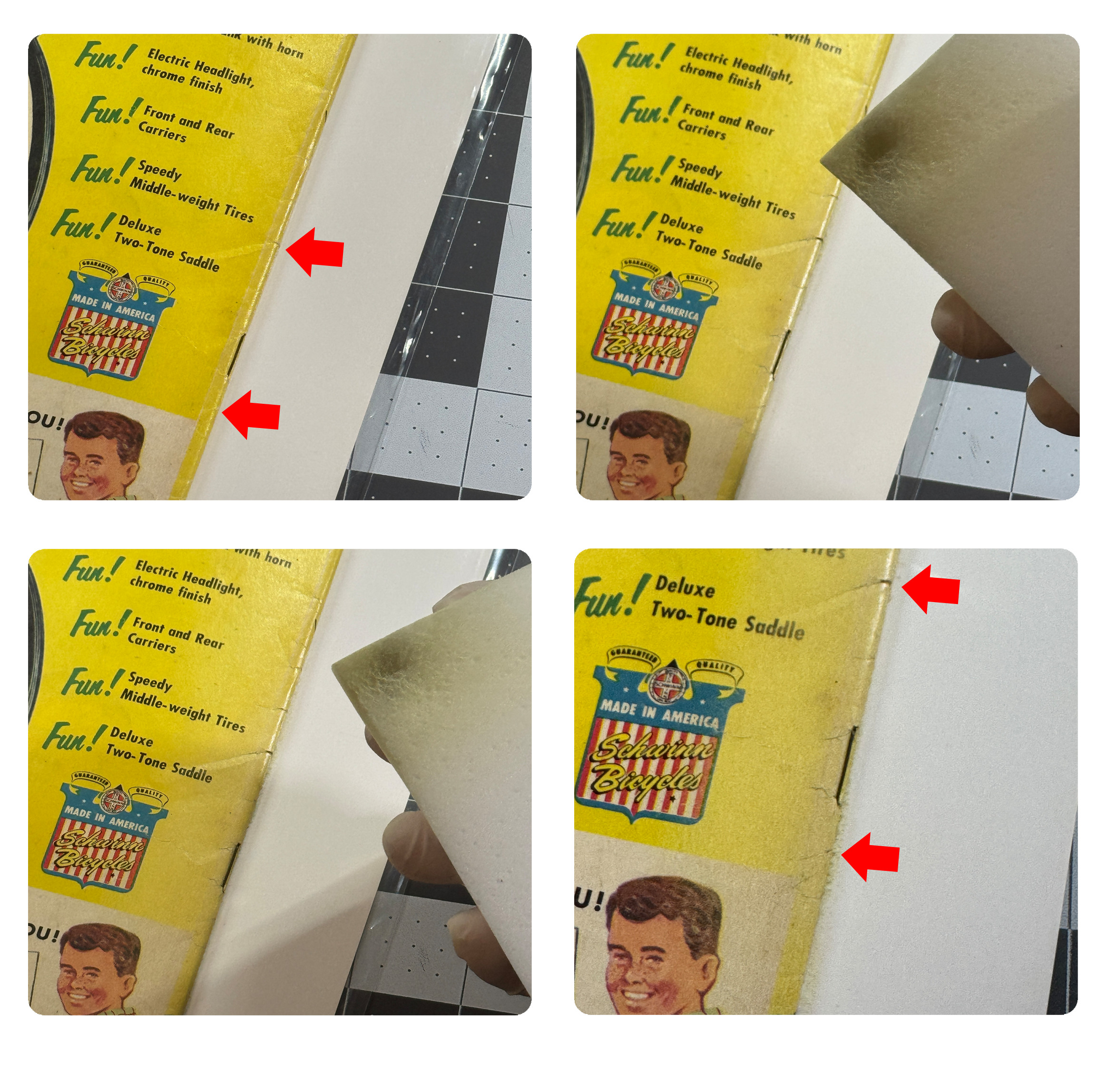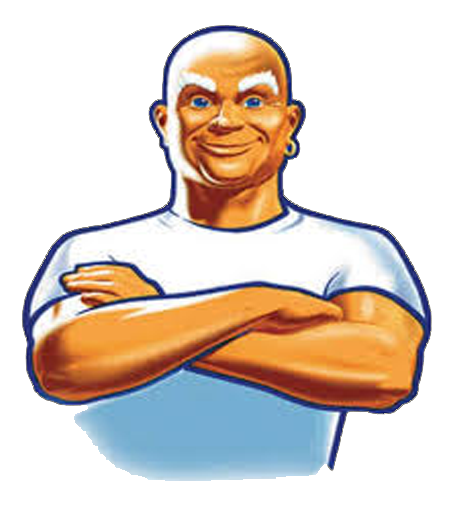
WHAT
IS COMIC BOOK DRY CLEANING?
Comic book dry cleaning is the process of removing soiling
and light staining using no harsh chemicals or solvents.
Over time, the aging process is not kind to comic books.
Something that was made to be thrown away is difficult
to retain the state of near mint condition. There are
many defects and soiling that cannot be removed by simple
dry cleaning. Several pressable defects can be safely
removed using dry cleaning methods. The goal is to clean
a comic book as if nothing ever happened to the book.
This makes the overall grade and eye appeal of the book
increase considerably. Comic book dry cleaning is not
restoration. Consider dry cleaning a process of comic
book conservation. A simple small grade bump can sometimes
mean a difference in thousands of dollars. You can save
money by dry cleaning your own comic books using basic
supplies from your home office or kitchen. Most items
can be purchased directly on Amazon or eBay to save
time, money, and shipping costs. Start small with some
cheap dollar bin comic books or reader copies.
This guide like my other one will require countless
hours of patience, practice and time. Click on any
photo to zoom to full size and see all its glory before
you.
MATERIALS
NEEDED FOR CLEANING COMIC BOOKS
Most materials can be purchased on Amazon
or Ebay. Buy your SRP paper and backer boards in bulk
to save money where needed. Absorene Putty lasts a long
time as long as you keep the tub sealed airtight when
not in use. Please
refer to our product links page for recommended products.
DRY CLEANING
COMIC BOOK TOOLBOX
Use all the tools in your toolbox for
dry cleaning comics. This ranges from non-invasive to
more aggressive stages of comic book dry cleaning.
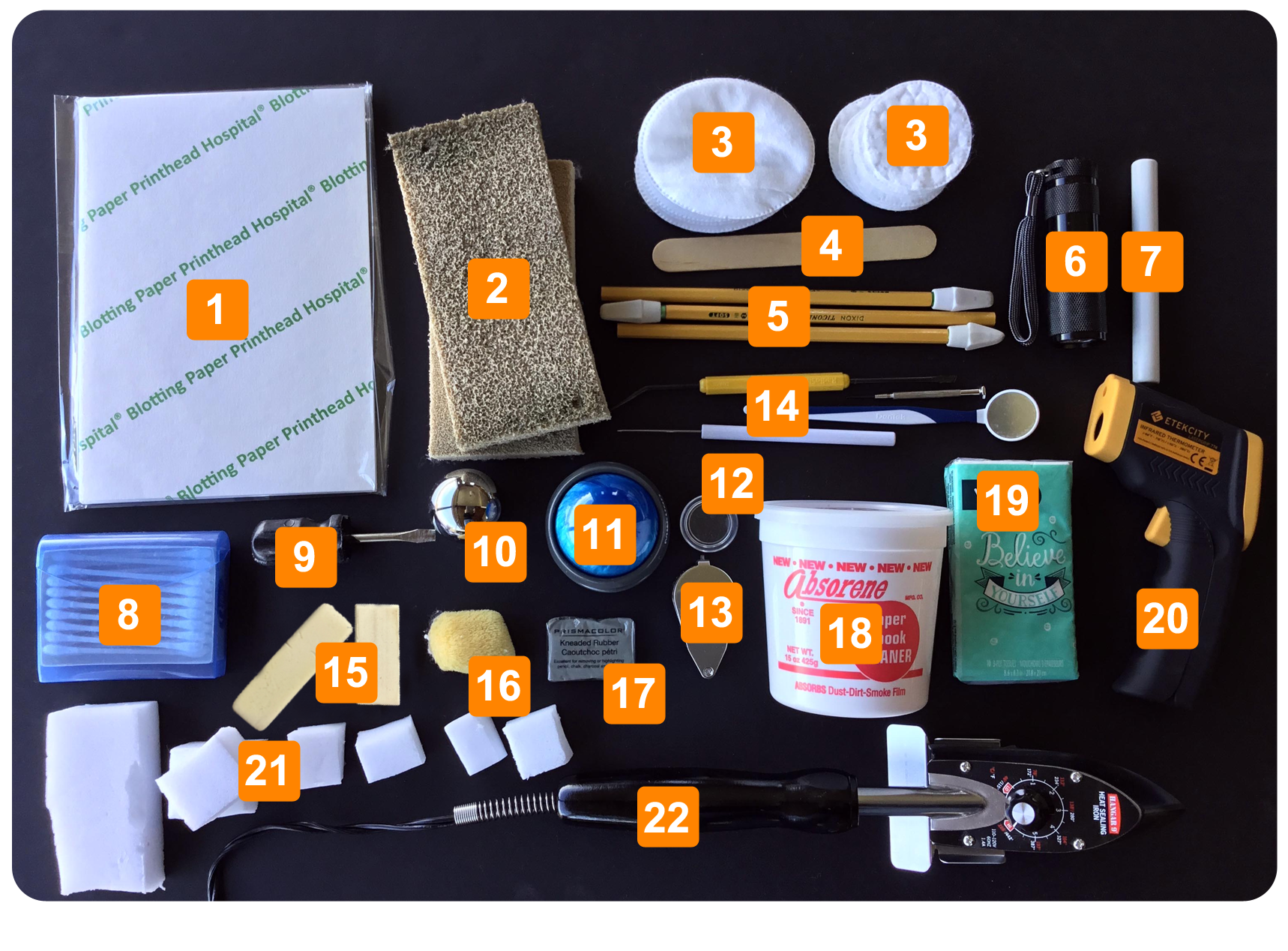
The comic book dry cleaning tools used to safely and
effectively clean comics. These products are highly recommended
for cleaning comics.
You will use many different products to
clean comics. These are the main tools you will need to
use. All of these products should be used gently and lightly.
Small circular motions, back and forth, left to right,
diagonally. Try different light motions to see which motion
will effectively lift a light stain or debris from comic
book covers.
Here is a full list of tools from left to right, row by
row:
1. Blotter Paper Used
for drawing up light staining using very simple liquid
wet cleaning methods.
2. Absorene Eraser Pad For removal
of surface grime on covers. Cut into 1” or 2” strips for
different cleaning maneuvers.
3. Makeup Remover Cotton Rounds For removal
of surface grime on covers.
4. Tongue Depressor / Craft Sticks / Bone Folder
Used instead of bone folder tool for pushing out spine
ticks from inside.
5. Number 2 Pencils with Helix brand
White Soft Eraser Caps – Recommended for corners,
edges, and white/light areas.
6. UV Black Light Flashlight Place a
sheet of copy paper under covers to detect pin holes.
Avoid pin holes during cleaning.
7. Pocket Handheld Pen Flashlight Alternate
light source for detecting surface dirt and pressable
defects.
8. Q-Tips Dip Q-Tip in a water bottle
cap. Use damp Q-Tip inside and outside a folded over crease
before opening fold.
9. Small Flathead Screwdriver for opening
a graded comic book case.
10. 1.5" Ball Bearing or Massage Roller Ball
Used with a tack iron, for dent removal.
11. Massage Roller Ball Alternative to
Ball Bearing.
12. Tiny Magnifying Plastic Lens Visual
assistance tool for spine, staples, binding, edges.
13. Jeweler's Loupe Visual assistance
tool for spine, staples, binding, edges. There are some
with LED lights.
14. Dental Picks and Dental Mirror, Eyeglass Screwdriver
Used for lifting/placing corner flaps, tears, and flaking.
No fingernails.
15. PVC Plastic Erasers Soft PVC plastic
erasers like Moo, Acurit Vanish, Tamaki or M&G brands
are the primary dry-cleaning method.
16. Sea Sponge Abrasive cleaner not recommended
for most covers or applications. Last resort.
17. Kneaded Eraser Another form of putty
like eraser used to clean surface grime from spine, cover,
and edges.
18. Absorene Book Cleaner Putty
Roll small logs across cover surface to lift dirt and
grime.
19. Travel Size Lotion Free Facial Tissues Start
by wiping book cover surfaces before dry cleaning.
20. Infrared IR Thermometer Gun Verify
temperature of tack iron to avoid burning book. Take readings
from copy paper, not iron.
21. Mr. Clean Magic Erasers Abrasive
cleaner recommended for white, or cardstock covers. Cut
into 1” squares. Last resort.
22. Tack Iron Digital or analog. It can
be used to heat up surface of book before dry cleaning.
For dent removal.
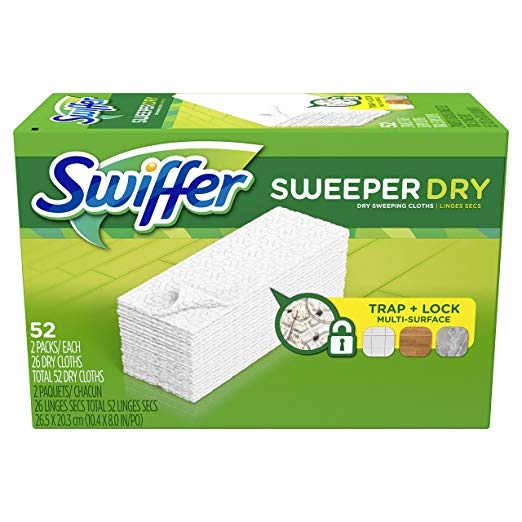
Also, worthy of consideration is Swiffer brand
dry mop dust sheets as cleaning pads. This product
is great and will safely lift most dirt and grime layers
off comic books. Try it!

My dry cleaning
toolbox of various tools and cleaners. My most widely
used items I placed inside a metal storage tin. The other
less used items or items that take up space I placed in
a larger plastic storage container. Take notice of the
ball bearing, magnifying glass, jeweler's loop, kneaded
eraser, natural sea sponges, pencils with eraser tops,
UV blacklight flashlight, Absorene putty, and two Absorene
book cleaner pads.
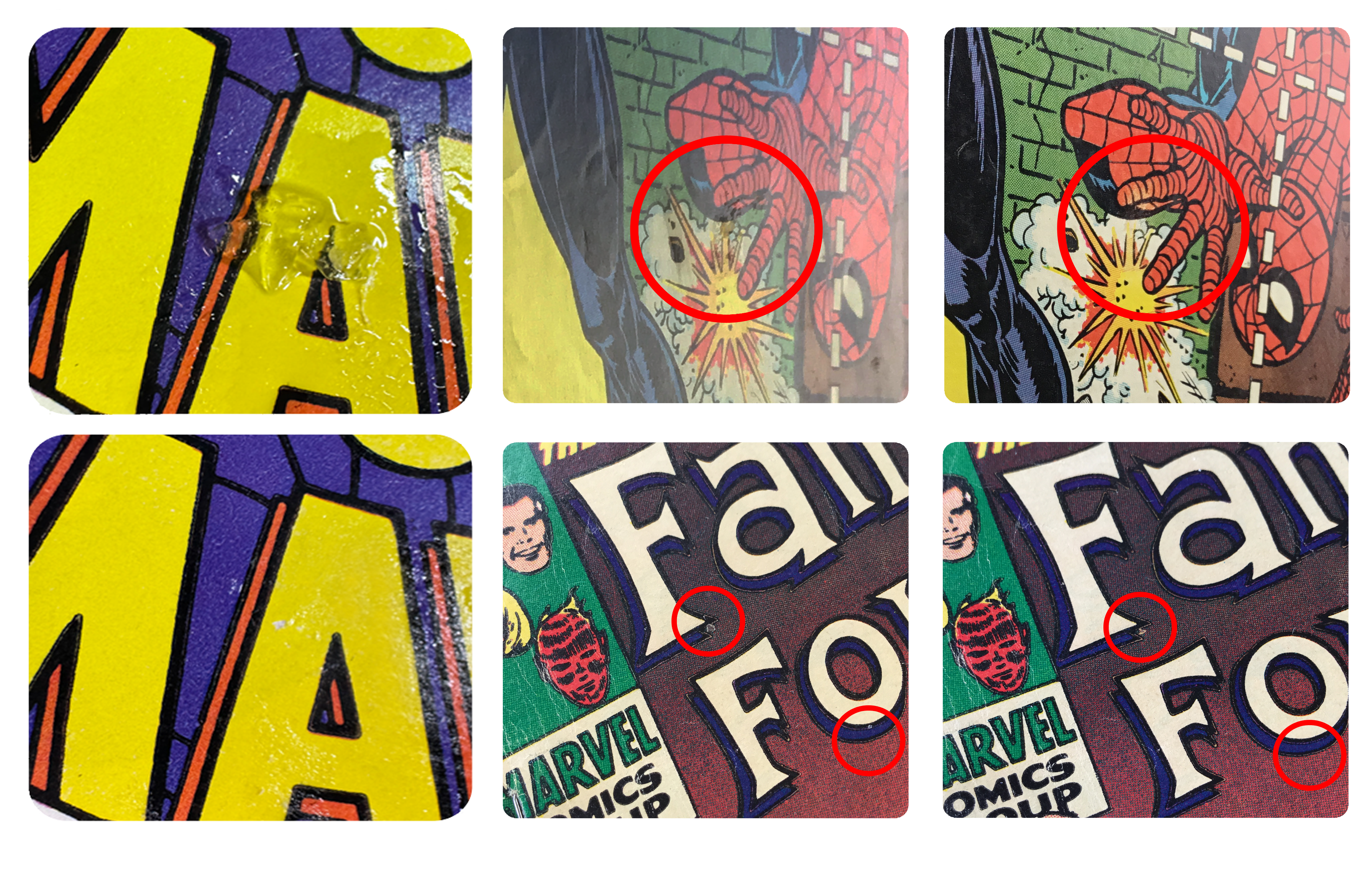
REMOVE
FOREIGN SUBSTANCES BEFORE PRESSING
If a comic book has any food residue, sticky material
(like hard candy or glue), or foreign debris on its surface,
pressing it without cleaning will lock that material into
the cover permanently. Heat and pressure from the press
act like a laminator—melting or flattening the substance
into the fibers of the paper. Once that happens, it’s
almost impossible to reverse. Not only will the comic
lose value, but you’ve also created a long-term stain
or indentation.
Tools to Use for Safe Removal:
• Dental pick or electronics probe –
Using sharp pointy tools like a dental pick should be
used cautiously. Scraping with anything sharp and metal
cause additional ink loss. Sharp metallic tools are destructive
in nature but recommended mostly for restoration removal
– for scraping color touch off spine ticks along the spine
and cover.
• Small plastic putty knife – These
are flat, smooth tools (similar to a bone folder but non-stick).
They let you gently lift dried material without scratching
gloss.
• Micro spatula – Thin and flexible
for sliding under sticky candy or glue without gouging
the paper.
• Q-tips & distilled water (sparingly)
– For dried food or sugar spots, a very lightly dampened
swab can soften the debris before carefully lifting it.
Always test in a tiny area first.
• Absorene putty or Absorene cleaning pad
– For dry, crumbly substances that aren’t bonded too hard
to the cover.
WHAT HAPPENS IF YOU DON'T
REMOVE FOREIGN SUBSTANCES
Machine Damage: That foreign material
can transfer to your press plates, and once the heated
metal picks it up, it can re-transfer to the next comic
you press—ruining multiple books.
Indentation or Divot: Yes, the press
will actually push that lump into the cover and back cover,
creating a permanent embossed divot. Even if you remove
the substance later, the dented paper fibers will remain.
Heat Reaction: Sticky materials (like
gum, tape, or glue) can melt under press heat and spread
further, permanently fusing into the cover’s gloss layer.
Think of pressing as the final step—not
the cleaning step. If the surface isn’t perfectly smooth
and free of contaminants, you’re not just wasting your
time pressing, you could be making the comic worse and
damaging your equipment. Always take the extra 5–10 minutes
to carefully remove anything foreign before the book ever
touches your press
PRESSING
FOLDS AND FLAPS
When pressing out folded over corners and flaps, it’s
important to introduce localized humidity directly on
each crease first before attempting to return the paper
to its original position. Paper becomes dry, cracked,
and brittle over time. If moisture isn’t applied first,
the paper will tear.
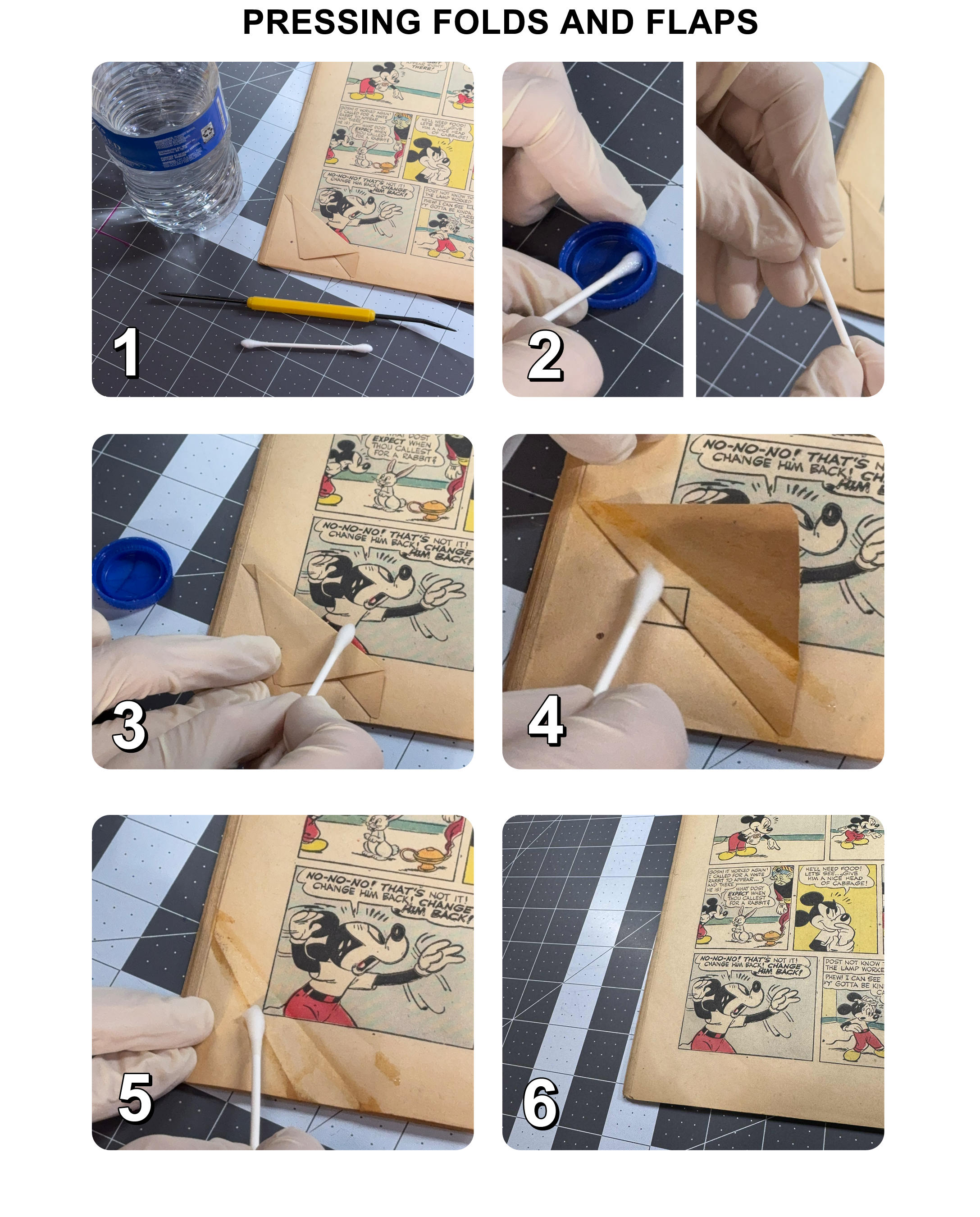
1. Gather your supplies: bottled drinking
water, a probe, and a clean fresh cotton Q-Tip.
2. Pour a tiny bit of water inside the
cap. Dip Q-tip in water. Squeeze out the excess water
from Q-tip using your fingertips. The Q-tip should now
be damp and not dripping wet.
3. Apply the damp Q-tip to the outside
edge of outermost crease first. Slowly
open the first fold to see any additional folds underneath.
Use either a probe or the Q-Tip to lift the fold.
4. If there are additional folds, apply the damp Q-tip
to the outside edge of the next fold.
Next, apply more moisture with the damp Q-tip on the inside
of the first fold as well.
5. Once all folds have been humidified on both sides,
return the paper to its original flatness.
Blot dry any excess water beads or moisture using a dry
cotton round or blotter paper.
6. Complete any required dry-cleaning
steps. Proceed to use the humidity tank.
Perform any dent removal procedures as needed. Press
the book as usual while performing the basic comic book
pressing procedure. Follow the recommended guidelines
to the required matching formula page based off the year
of publication.
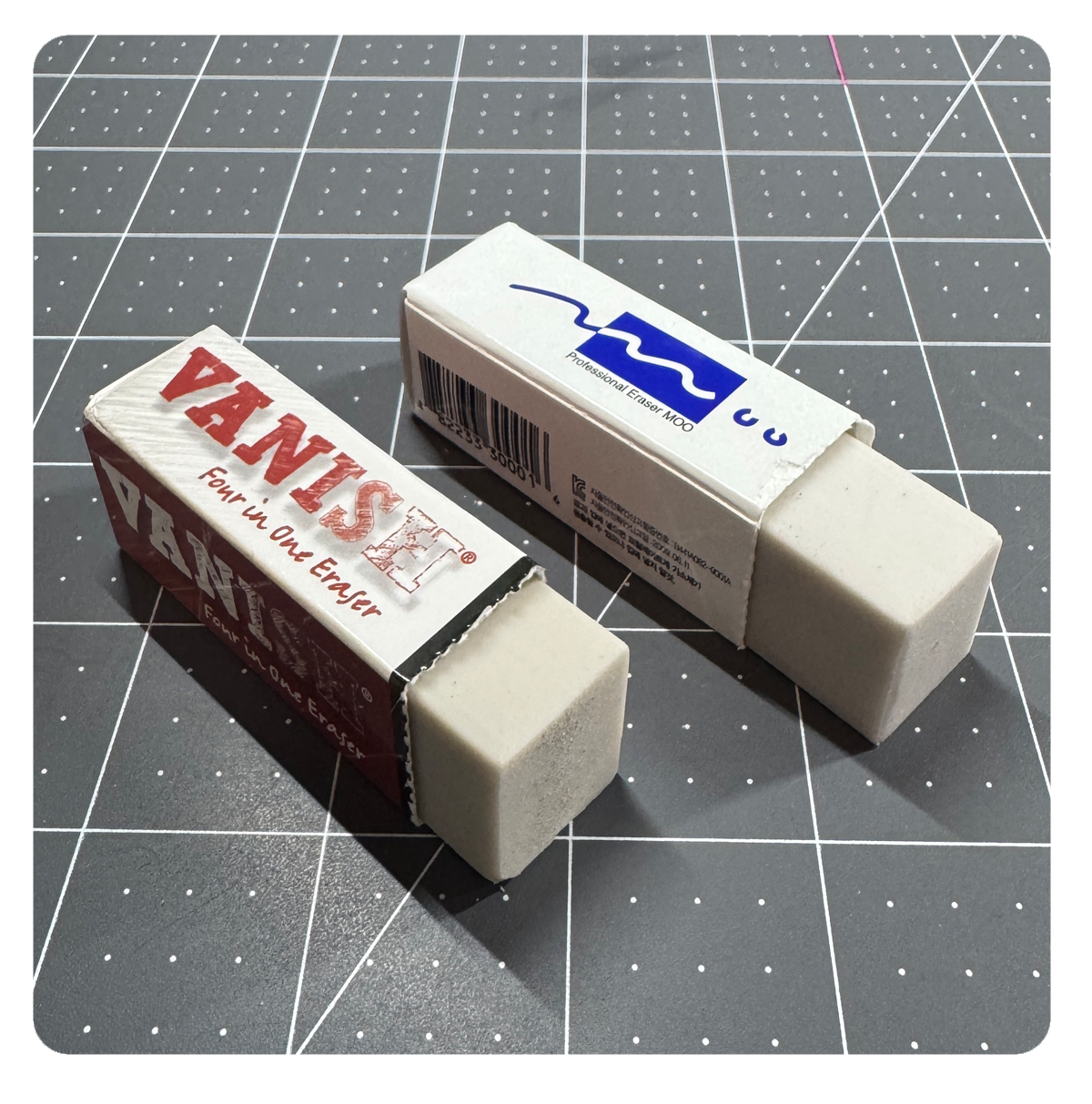
DRY CLEANING ERASERS
The most important tool for dry cleaning is a good plastic
PVC art eraser. The eraser must be super soft and pliable,
so the cover doesn’t tear. The number one recommended
product we prefer to use is a MOO art eraser.
Unfortunately, the MOO company is no longer in
business, so sourcing this eraser is difficult. There
are sellers on eBay that offer the eraser typically from
as low as $10 to as high as $30. This eraser is actually
worth the $30. If you can find them, buy them. The closest
eraser I have found that is almost identical to the MOO
eraser is Acurit Vanish Four in One Eraser.
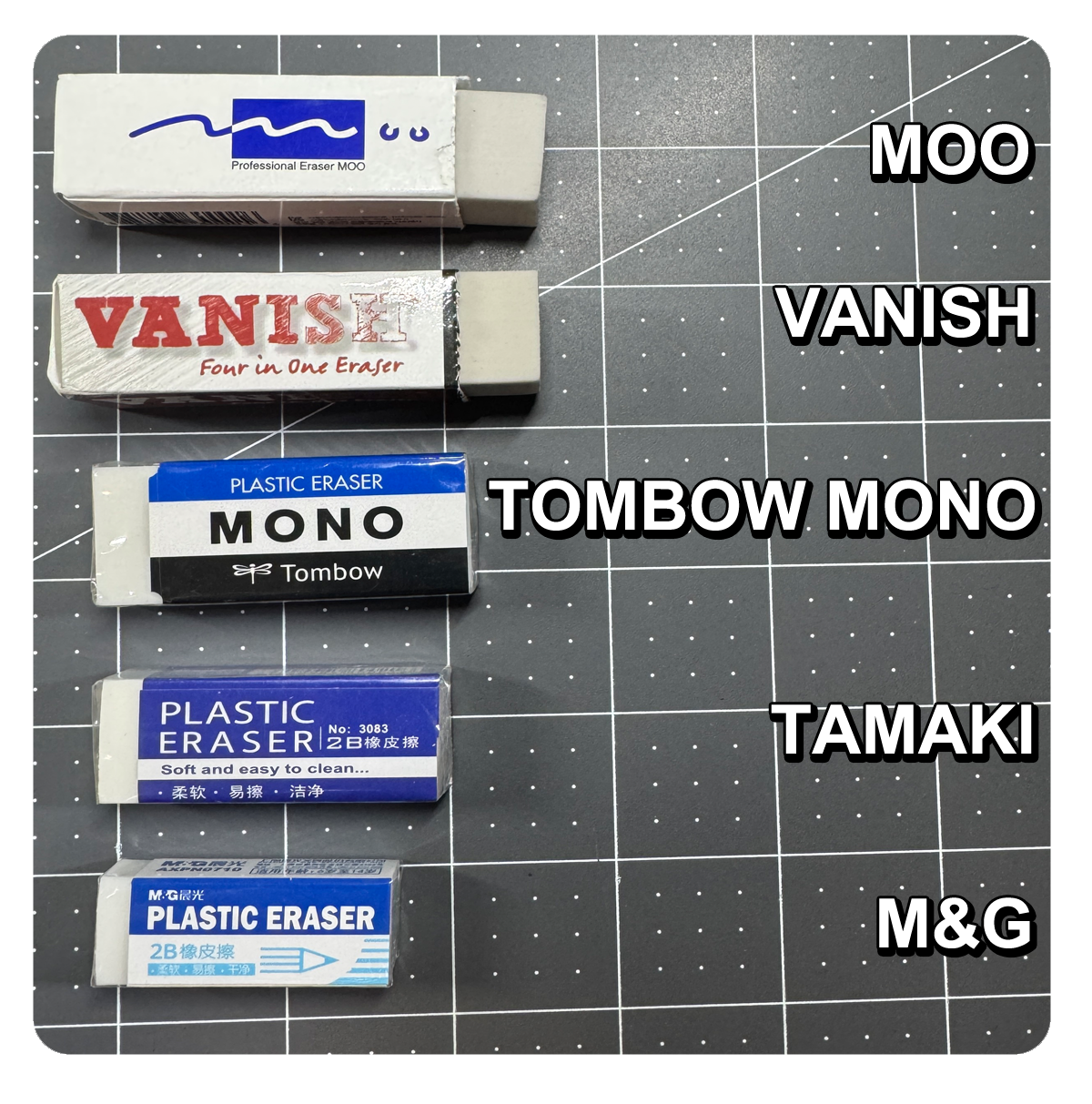
ALTERNATIVE
ERASERS
In our conquest to find and purchase alternatives to a
$30 eraser, we did find suitable replacements. We tested
over 12 different brands from Amazon and Walmart.
The key issue here is to use the softest eraser available.
The softer the eraser, the easier it is to lift soiling
from comic book covers. On Amazon there are some
brands we thought were a close match (but not the same).
Acurit Vanish, Tombow Mono, M&G and Tamaki brand
erasers are the best soft plastic PVC erasers we could
find for dry cleaning comic books.
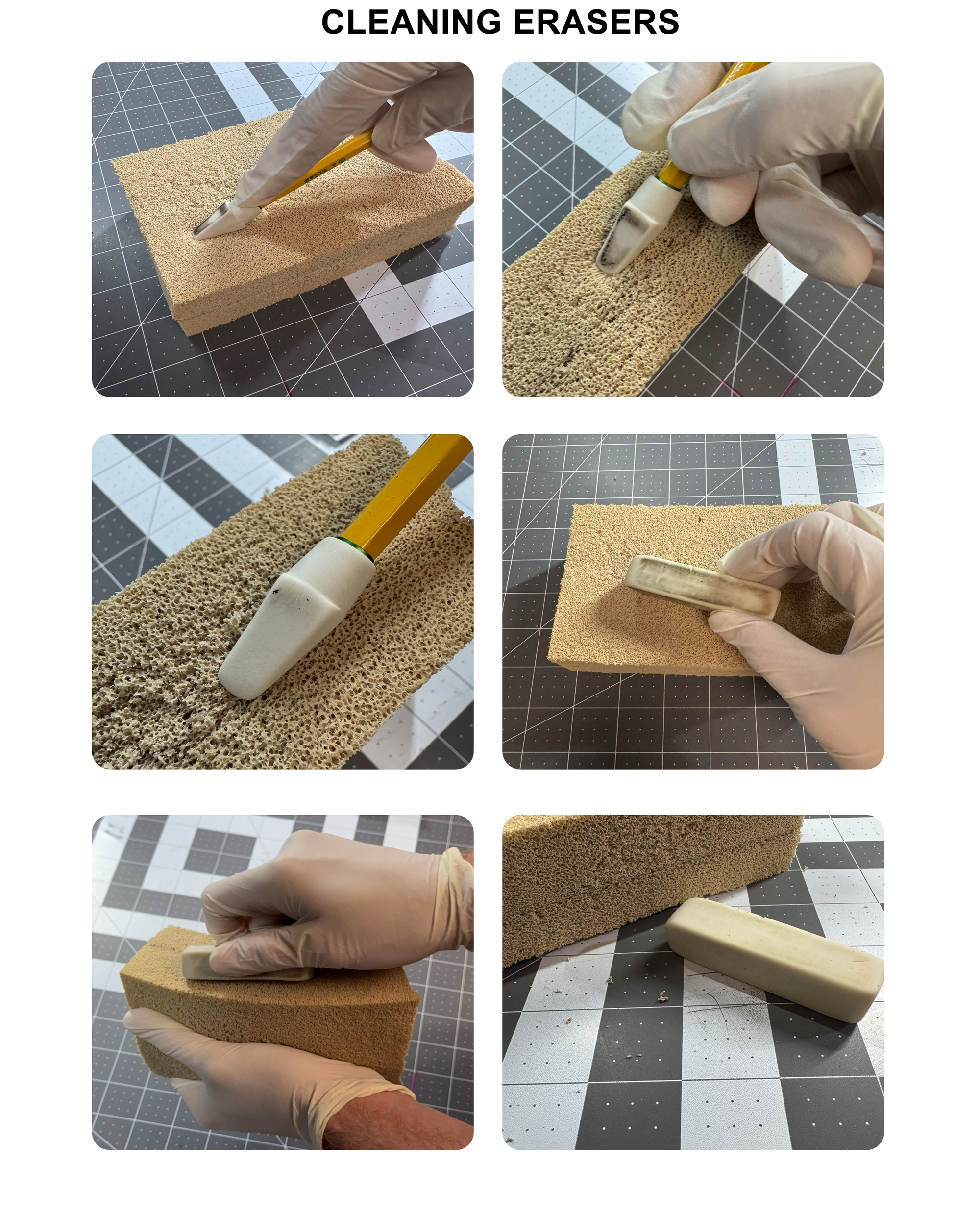
CLEANING
ERASERS
PRO TIP! The erasers
used for dry cleaning comic books become quite soiled
and dirty after each use. Fortunately, the erasers are
reusable – all you have to do is clean the erasers using
the Absorene book cleaner pad. Rub erasers back and forth
across the book cleaner pad. The book cleaner pad is made
of vulcanized rubber, so you are erasing the dirt from
one eraser to another.
Helix brand pencil cap erasers are most effective around
edges, corners, along the spine, and any white/light areas
of comic book covers. Think of the pencil cap eraser as
a fine edging tool for cleanup once the Absorene pad and
soft PVC erasers have done most of the dry cleaning.
All erasers can be reused many times, cleaning hundreds
of books. An eraser should be retired once all edges are
warped and no longer flat, or if there is significant
cracking.
DRY CLEANING
COMICS IN STAGES
Approach every book with cautious cleaning
tactics. See what is effective with the least effort.
Less invasive first, to a more increased aggressive cleaning
stage each time, to see what works. Start small, slowly
increasing your efforts:
1. Start by carefully chipping or scraping
away surface debris like boogers, candy, or mud with a
dental pick. A plastic putty knife or eyeglass flathead
screwdriver will also work.
2. For vintage stapled squarebound comics, press down
staples flat with a plastic putty
knife or flathead screwdriver.
Those 2 are priority before you begin any dry cleaning.
Start small and work your way down the list, in order,
one-by-one, as needed:
1. WIPE - Swiffer Duster Dry Wipe Sheets,
Lotion free tissue, or a cotton round.
2. ERASERS – Use soft PVC erasers like
M&G, MOO, or TAMAKI. Alternatively, use white polymer
eraser head caps with a number 2 pencils. Avoid pink erasers.
3. DRYER SHEETS - Unscented Dryer Sheet
with pencil and eraser head as a "handle".
4. PAPER TOWELS - Unscented Paper Towel
with pencil and eraser head as a "handle".
5. ABSORENE ERASER PAD - Great
for bright colored inks on cover.
6. ABSORENE PUTTY - Roll into
logs across book cover surface gently.
7. MAGIC ERASER - Use with caution
across white and light areas. Avoid black, red, and yellow
inks with this product. Recommended for white cardstock
covers and sketch covers.
8. DRAFTING ERASER PAD - Use with caution.
The little, tiny bits of eraser shavings will get everywhere
– all over your workstation area and comic book. Make
sure you have wiped up all shavings or you will press
divots into both book covers.
9. COTTON ROUND – Use a makeup remover
cotton round at the end to polish finish any remaining
debris from dry cleaning. Alternatively, use a Swiffer
Sweeper Dry Wipe Sheet.
Alternate between all of them and you will yield better
results. The primary dry-cleaning tools should be 1-5.
Tools 6-8 are abrasive and have been known to cause problems
for most amateur dry-cleaning enthusiasts. Use the abrasive
tools 6-8 sparingly. Finish off dry cleaning with a cotton
round as a final polishing step.

